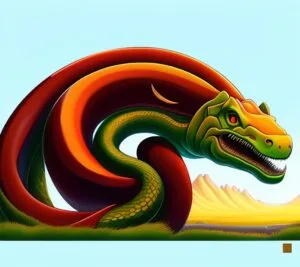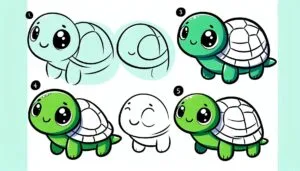Creating a drawing of a tree frog is a wonderful opportunity to showcase the vibrant hues and distinctive traits of these fascinating amphibians. Renowned for their vibrant green bodies and unique adhesive feet, tree frogs make for an excellent artistic inspiration. In this guide, we will take you through the process of drawing a tree frog, paying close attention to its unique characteristics and incorporating some creative elements. Let’s dive into this imaginative journey!
The Fascination of Tree Frog Anatomy
Tree frogs are famous for their vibrant hues, mesmerizing eyes, and unique feet. By familiarizing yourself with these features, you’ll be able to produce drawings that are both precise and captivating. By exploring the tree frog’s anatomy, one can truly appreciate the charm and uniqueness of this captivating creature.
The Joy of Capturing Vibrant Colors
Creating a drawing of a tree frog requires capturing its vibrant green hue and unique markings. This can be an enjoyable and imaginative challenge, improving your drawing skills and your knack for working with color. The more you emphasize these characteristics, the more vibrant and authentic your tree frog drawing will appear.
Discovering the Fascinating World of Tree Frogs Through Art
Tree frogs come in a wide range of species, each showcasing their own distinct colors and patterns. Exploring the various forms and characteristics of tree frogs can be quite fascinating. This theme highlights the educational aspect of art and the opportunity to explore new aspects of amphibian life through creative expression.
Steps: Drawing a Tree Frog
First, start by drawing the body.
Begin by sketching the fundamental outline of the tree frog’s body. Start with a rounded, oval shape for the main part of the body. Tree frogs have a compact and somewhat flattened body, so it’s important to capture their unique shape. Create a smaller, rounded section at the front for the head.
Step 2: Incorporate the Head and Facial Features
Place the head at the front of the body, shaping it with a broad and rounded form. Place two large, circular eyes towards the top of the head, and add a small, curved line beneath each to represent the eyelids. Create a petite, gently arched line to form the mouth, placing it in close proximity to the center of the head. Tree frogs have unique, slightly bulging eyes, so be sure to capture this characteristic.
Step 3: Now let’s move on to drawing the legs.
Tree frogs possess elongated legs and feet that are adapted for their unique needs. Extend the hind legs as elongated, gracefully curved shapes from the rear of the body. Include webbed feet with four toes each, extending from the legs. Make the front legs appear shorter and more rounded, extending from the sides of the body. Don’t forget to add webbed feet too.
Step 4: Perfecting the Form
Opt for a darker pencil or pen to carefully trace and enhance the contours of the tree frog. Refine the contours of the body, head, and legs. Make sure the legs have a natural, elongated look and that the webbed feet are clearly defined. Remove any unnecessary guidelines or overlapping lines to tidy up your drawing.
Step 5: Enhance the visual appeal with various textures and patterns
Tree frogs typically possess smooth skin adorned with distinct patterns and vibrant colors. Create some gentle, curved lines or spots on the body to depict these patterns. Adding a touch of texture to the skin can enhance its realism. Enhance the eyes by adding intricate details like pupils and highlights, giving them a more realistic appearance.
Step 6: Add some color to your tree frog.
Now it’s time to add some vibrant hues to your tree frog! Incorporate a range of green hues for the body, complemented by lighter greens or yellows on the underside and legs. Enhance the appearance with some brown or darker green spots or stripes for a more natural, camouflaged effect. Consider using light blue or gray for the eyes and incorporating shading to add depth and dimension to your drawing. Take note of the light and shadow areas to enhance the realism of your tree frog drawing.
Theme 1: Exploring the Fascinating World of Tree Frog Anatomy
Exploring the anatomy of a tree frog through drawing reveals fascinating features like its large eyes, slender legs, and specialized feet. Understanding these features enables you to craft a thorough and authentic portrayal. Recognizing the allure of tree frog anatomy can enhance both your artistic abilities and your understanding of these captivating amphibians.
Theme 2: Embracing the Joy of Capturing Lively Colors
The vibrant hues and intricate designs of a tree frog present an enjoyable challenge for artists. Mastering these details demands imagination and expertise, making it an excellent activity for exploring different hues. Find joy in the process of bringing these vibrant features to life in your artwork.
Theme 3: Discovering the Fascinating World of Tree Frogs Through Art
Exploring the diversity and beauty of different species, drawing tree frogs can be a fascinating experience. Exploring various colors and patterns can add visual appeal and educational value to your artwork. This theme celebrates the excitement of exploring new dimensions of amphibian life through artistic expression.
In summary
Drawing a tree frog can be a fun and exciting activity that lets you showcase the vivid colors and distinct characteristics of this captivating amphibian. By following the steps in this guide and paying attention to its structure, characteristics, and vibrant hues, you can create a meticulous and captivating tree frog drawing. Embrace the joy of creating and let your imagination soar as you bring this amazing creature to life on paper!


Check out this super fun and simple guide to learn how to draw a caecilian with easy step-by-step instructions! This fun tutorial provides easy steps, allowing young creators to dive into their imagination while discovering more about this intriguing amphibian!





